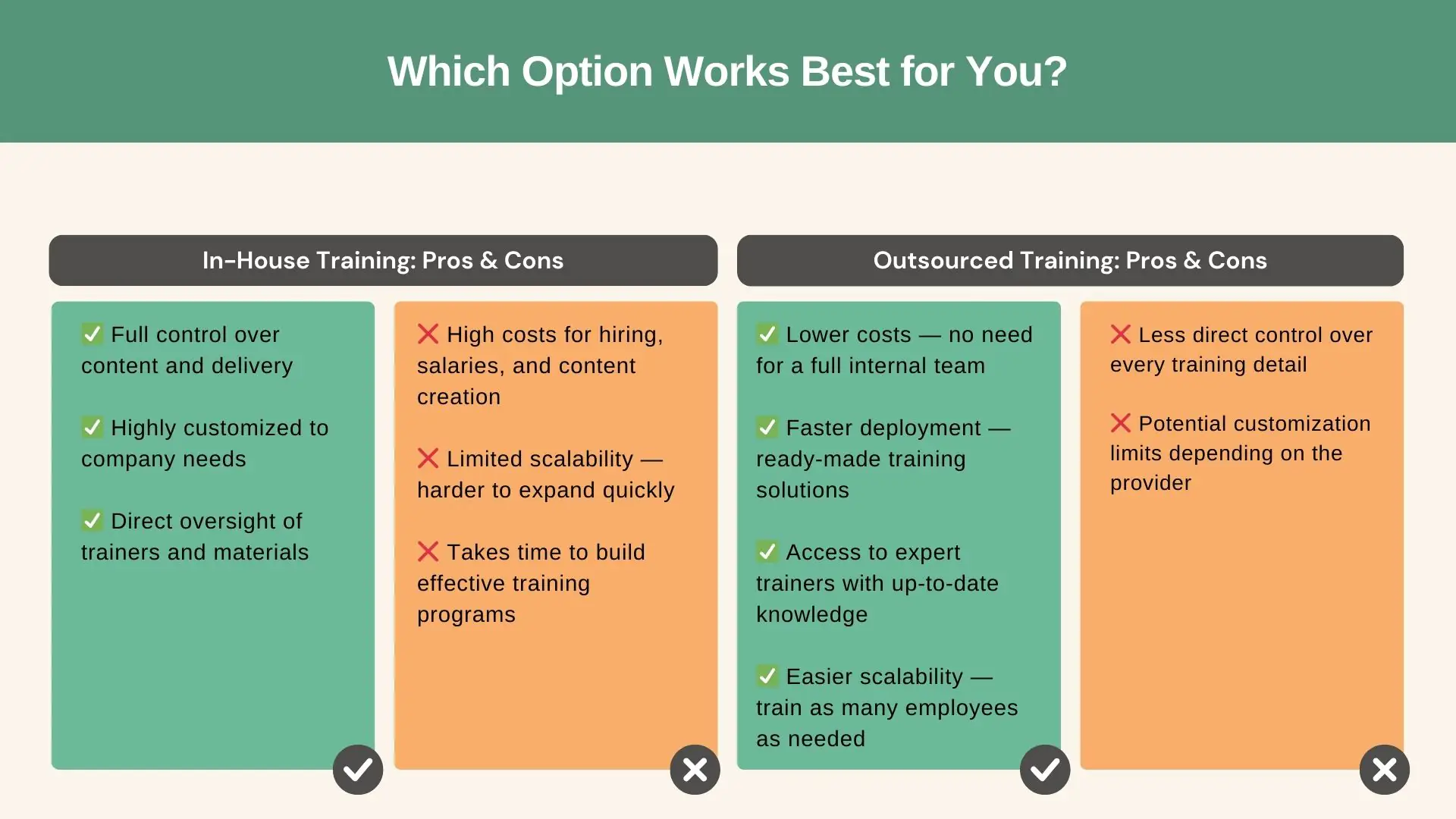When we discuss the potential benefits of outsourcing training development, particularly its economic side, the question arises: To be or not to be? The answer to this question can be found in statistics, which stubbornly show that in 2024, 56% of U.S. training companies used outsourcing services for training initiatives. Why? Because it helps them save time, reduces costs, and provides expert-led training almost immediately.
Whether onboarding new employees or meeting industry rules, internal teams often can’t do it all. Outsourcing lets businesses get training solutions without overloading their teams. Our company’s case study, in which Raccoon Gang’s instructional design team has helped the EBRD create e-learning modules for the Policy Academy, serves as an example.
Discover More Business Cases About Outsourced Training! → Explore Case Studies
So, if over half of the training companies are outsourcing, it’s worth considering whether this approach could also work for your business. Our guide will help you decide.
What You’ll Learn:
- Why businesses outsource training
- In-House vs. Outsourced Training
- Different outsourcing models
- How to outsource training the right way
Benefits of Outsourcing Training Development
Let’s face it: no company wants to incur extra costs for a direction like training development. Yes, this direction is important. Yes, it has long-term benefits for the company, but honestly, here and now, you wouldn’t want to pay a lot for it. Right?
Handling all the nuances of compliance issues or even just regularly updating training materials is very time-consuming. That’s why more than half of companies are leaning towards outsourced training and development methods.
Why Businesses Choose to Outsource Training and Development
- Lower Costs. Hiring full-time trainers, creating content, and managing an internal team is expensive. Outsourcing reduces costs by giving you access to expert training without the overhead.
- Compliance Made Easy. Regulations change fast. Whether it’s safety laws, industry standards, or HR policies, outsourced providers ensure training stays compliant and up to date.
- Scalability & Flexibility. Need to train hundreds of employees across multiple locations? Outsourcing lets you expand training programs quickly without overloading your team.
- Access to Experts. Training companies specialize in creating engaging, high-quality content with the latest learning strategies, ensuring employees get the best experience.
- More Focus on Core Business. Instead of spending time managing training programs, HR and leadership teams can focus on strategy, growth, and employee development.
Do You Need to Outsource Training?
If your business needs to…
- Meet compliance requirements (e.g., safety regulations, HR policies)
- Improve employee skills (e.g., software training, leadership development)
- Enhance customer service (e.g., sales and support training)
- Scale training programs quickly without hiring an in-house team
…then outsourcing training and development might be the best solution.
“Some benefits of outsourcing training and development often do not manifest themselves immediately. As we see in our partners’ projects, the real impact becomes clear over time. Many companies initially outsource to fill a short-term gap, but they soon realize that training quality far exceeds their expectations.” — BizDev Lead at Raccoon Gang.
In-House Training vs. Outsourcing: Which is Right for Your Business?
When choosing between two approaches to outsourcing corporate training, it is worth focusing on the main thing. No solution or product can be high-quality, cheap, and quickly implemented. You can only check off two of the three qualities.
- If it’s high-quality and fast, it won’t be cheap.
- If it’s cheap and fast, it won’t be high-quality.
- If it’s cheap and high-quality, it won’t be implemented quickly.
When you implement training initiatives yourself, you gain full control over what they will look like. At the same time, outsourcing can speed up the process of creating or updating all learning materials.
Side-by-Side Comparison: In-House vs. Outsourced Training
| Factor | In-House Training | Outsourced Training Development |
| Costs | High (salaries, tools, content creation) | Lower (pay per service, no long-term overhead) |
| Scalability | Limited (hiring & training take time) | High (easily scale to meet demand) |
| Expertise | Internal knowledge may be limited | Access to top industry experts |
| Customization | Fully tailored but time-consuming | Pre-designed or customized solutions available |
| Speed to Launch | Slow (requires planning & development) | Fast (ready-to-use or quick implementation) |
| Flexibility | Requires internal resources for changes | Flexible solutions with provider support |
Use Cases
- Tech Startup (50 Employees): A growing tech company needed fast onboarding for new hires but lacked internal trainers.
- Healthcare Provider (1,000+ Employees): With strict compliance regulations, a hospital network struggled to keep up with policy updates.
- Retail Chain (500+ Locations): A nationwide retailer wanted to train employees consistently across multiple stores.
“In cases where your business cannot do without complete control and has the budget for a dedicated training team, in-house training may be the right fit. Conversely, if expert-led and scalable training is the main filter for your decision, outsourcing is the smarter choice.” — BizDev Lead at Raccoon Gang.
Outsourcing Training Models to Consider
So, when it comes to outsourcing training development, let’s take a business approach by looking at all the features under a microscope. It could be an outsourced model, or it could look like a collaborative approach that blends internal and external expertise. Your budget, resources, and training goals should determine which of the above models is best for you.
Let’s explore deeply the two main outsourcing management training models and when to use them.
Fully Outsourced Training Model
Best for businesses that need a complete training solution without internal management.
In this model, a third-party provider handles everything — from course design and content creation to delivery and assessment. This is ideal for businesses that:
- Lack an internal training team and need expert-led programs
- Need to scale quickly without hiring additional staff
- Want training aligned with industry best practices and compliance
Potential Drawback: Less direct control over course customization and delivery.
Collaborative (Hybrid) Outsourcing Model
It is best for companies that want to combine internal knowledge with external expertise.
This model keeps some training functions in-house while outsourcing specific parts, such as:
- Course content creation
- Instructional design support
- Compliance training updates
Potential Drawback: The model requires strong coordination between internal teams and external vendors.
Best Practices for Outsourcing Training Development
Does outsourcing training development seem like a good option for you? Let’s take a look at what to look for when looking for a vendor.
1. Don’t rush into a partnership.
Don’t jump in headfirst. Take time to research. Look for:
- Experience in outsourcing training development for your industry.
- Positive client reviews and case studies.
- Clear processes for creating, delivering, and updating training programs.
Expert Tip: Ask vendors for sample courses or a demo. This will give you a first-hand look at their content and delivery style.
2. Align training with organizational goals.
Communicate in detail with the vendor about their vision and understanding of your sector and industry. This is important, as a vendor may be very successful in some areas while having poor experience in others.
Key Steps:
- Transfer your company’s vision to the vendor.
- Provide detailed info about your training goals and audience.
- Whether it is quantitative or qualitative indicators, both you and the vendor should understand by what indicators you will measure the success of the collaboration.
3. The job isn’t done after launching the program.
As they say, there is no limit to sovereignty. There is always something to improve, including in the area of L&D. Use metrics like:
- Course completion rates – Are employees finishing their training?
- Knowledge retention – Are learners applying what they’ve learned?
- Feedback scores – How do employees rate the content?
Expert Tip: Work with your vendor to set up regular performance reviews and adjust training as needed.
“In practice, we see that the post-launch period is one of the most important parts of the project. At this time, we receive feedback from users and learners, get the first metrics, and can make some updates to the materials and the learning platform in general.” — Head of Support at Raccoon Gang.
How Raccoon Gang Helped NASA With Outsourced Training Development
NASA’s Open Science program was created as a set of structured modules to educate a global audience on scientific research principles. The program required high-quality instructional design but lacked the in-house capacity to build online courses.
The customer turned to Raccoon Gang as an outsourced training provider. Our outsourced training services include:
- Designing a clear, structured learning path
- Developing engaging, high-quality content
- Providing the curriculum aligned with NASA’s training objectives
The Results
- 5 structured modules covering key aspects of Open Science
- Engaging content delivery to enhance awareness and knowledge retention
- Designed by instructional design experts for an optimal learning experience
“Raccoon Gang’s strategic approach ensured the successful development and delivery of the Open Science 101 Curriculum. Our dedicated team worked on the five modules, including content managers, e-learning developers, instructional designers, and Subject Matter Experts from NASA.” – Raccoon Gang’s Learning Solutions Architect
Conclusion
In this article, we explored whether outsourcing training development is a smart move for businesses. As we have seen, it is. First, outsourcing often helps cut costs. Second, it gives you access to expert-led training solutions. Finally, it doesn’t overburden your teams.
To put it simply, outsourcing can provide an appropriate solution if your business needs to train employees faster. However, if you have the time, free hands, and money, you can always develop your own L&D initiatives and materials.
In the end, everyone always makes the correct decision for himself based on his capabilities. Peter Drucker, the godfather of modern management, once said, “Do what you do best and outsource the rest.”
🚀 Are You Looking To Scale Your Training Development? Contact us to learn how outsourcing can benefit your business. → Book and call.





